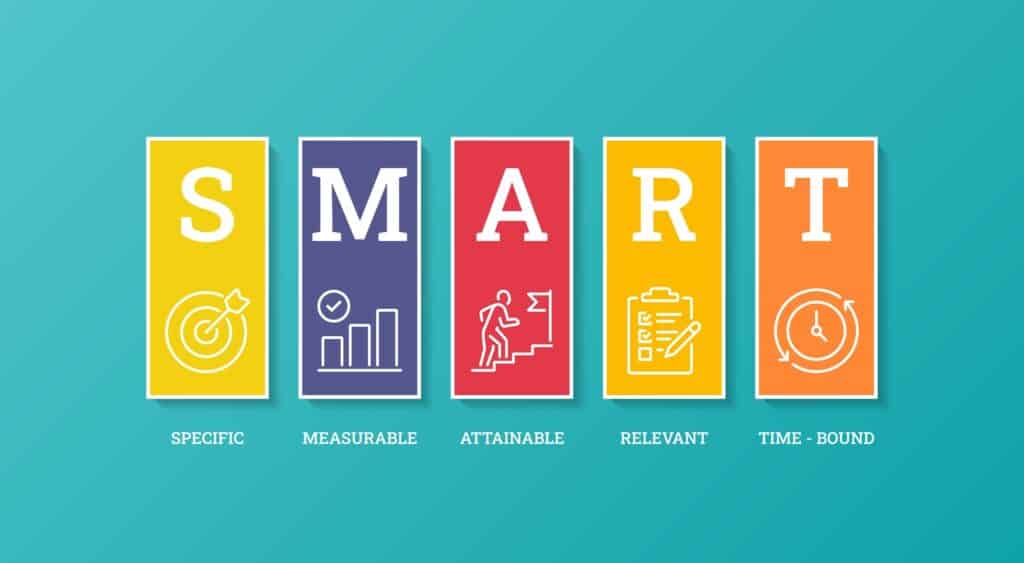The transformative power of setting clear targets is undeniable, especially when it comes to student achievement and fostering success in education. Simply telling students to “do better” or “study more” often falls flat; the intention is good, but the path forward remains unclear.
This is precisely where the power of SMART goals for students comes in. By guiding our students as educators, from K-12 goal setting all the way through higher education, to set objectives that are Specific goals, Measurable goals, Achievable goals, Relevant goals, and Time-bound goals, we equip them with a robust roadmap for success.
This not only drives academic gains but also cultivates crucial life skills like planning, self-monitoring, and resilience, ultimately boosting student self-efficacy.
Consider a common scenario: A student struggles with reading comprehension. A general directive like, “You need to improve your reading,” offers little actionable guidance.
But, if we help that student craft SMART goals examples for students, such as, “I will increase my reading comprehension score by 5 points on the weekly passages by reading aloud for 15 minutes each evening and answering three comprehension questions after each reading for the next four weeks,” the path becomes undeniably clear.
This shift from vague aspiration to concrete action is the essence of effective goal setting in education.
The Foundational Framework: What are SMART Goals For Students?
The SMART acronym provides a robust framework for developing well-defined and actionable academic goals and learning objectives. Let’s break down each component in the context of student learning, using SMART goals examples for students to illustrate each point:
S: Specific Goals – Pinpointing the Target
A specific goal clearly defines what needs to be achieved, who is involved, where it will happen, when it will happen, and why it is important. It eliminates ambiguity.
- Instead of: “I want to get better at math.”
- Consider: “I will correctly solve 8 out of 10 two-digit multiplication problems during our daily math practice.”
Why it matters for students: Specificity helps students visualize the target and understand exactly what is expected of them. It reduces overwhelming feelings often associated with broad, undefined objectives, forming a core educational strategy.
M: Measurable Goals – Tracking Progress and Success
A measurable goal includes concrete criteria for tracking progress and determining when the goal has been met. It answers the question, “How will I know when I’ve achieved my goal?” Let’s look at another one of our SMART goals examples for students:
- Instead of: “I will participate more in class.”
- Consider: “I will contribute at least one relevant comment or question during social studies discussions three times this week.”
Why it matters for students: Measurement provides tangible evidence of progress, which is incredibly motivating. It allows students to see their efforts yielding results and empowers them to self-assess, further developing their student self-efficacy.
A: Achievable Goals – Setting Realistic Expectations
An achievable goal is realistic and attainable, considering the student’s current abilities, resources, and time constraints. While challenging, it should not be impossible. Here’s a relevant one of our SMART goal examples for students:
- Instead of: “I will get a perfect score on every test this semester.” (Unless truly achievable, this can lead to burnout.)
- Consider: “I will improve my science test scores by 5% on the next unit exam by reviewing my notes for 20 minutes daily.”
Why it matters for students: Achievable goals build confidence and prevent frustration. When students consistently meet realistic goals, their student self-efficacy grows, encouraging them to set and pursue more ambitious objectives in the future.
R: Relevant Goals – Connecting to Purpose
A relevant goal aligns with the student’s broader academic goals, personal interests, or future aspirations. It answers the question, “Why is this goal important to me?” Consider this from our SMART goals examples for students list:
- Instead of: “I will complete my homework every night.” (While important, the ‘why’ might be missing for the student.)
- Consider: “I will complete all my history homework assignments on time so I can earn a B or higher in the course and be eligible for the school’s robotics club.”
Why it matters for students: Relevance provides intrinsic motivation. When students understand the purpose and value behind their goals, they are far more invested in the process and persistent in overcoming challenges. This directly contributes to student achievement.
T: Time-bound Goals – Establishing a Deadline
A time-bound goal has a clearly defined deadline or timeframe for completion. This creates a sense of urgency and provides a target date for achievement.
- Instead of: “I will read more books.”
- Consider: “I will read two non-fiction books related to environmental science by the end of the school year.”
Why it matters for students: Deadlines create accountability and help students prioritize. They learn to manage their time effectively and work towards a specific end point, a critical skill for academic and professional life.
Implementing SMART Goals in Your Classroom: Practical Steps for Educators
Integrating SMART goal setting into your teaching practice doesn’t require a complete overhaul; it’s about intentional guidance and an effective educational strategy.
- Introduce the Concept Explicitly: Don’t assume students understand goal setting. Dedicate time to explain the SMART acronym with clear examples relevant to their lives and academics. Use age-appropriate language, particularly for K-12 goal setting.
- Model the Process: Demonstrate how you would set a SMART goal related to a classroom objective or even a personal task. “My SMART goal is to provide feedback on all essays by Friday by dedicating 30 minutes each afternoon to grading.”
- Provide Structured Opportunities: Offer templates or graphic organizers that walk students through each component of a SMART goal. This scaffolding is especially helpful for younger students or those new to goal setting in education.
- Facilitate One-on-One or Small Group Conferences: Work with students individually to help them draft and refine their goals. Ask probing questions: “How will you measure that?” “Is that realistic for you right now?” “Why is this important to you?” This personalized approach is a key educational strategy.
- Encourage Self-Reflection and Monitoring: Teach students to regularly check their progress. This could involve using a goal-tracking chart, a simple rubric, or quick check-ins during class. Help them understand that setbacks are opportunities for adjustment, not failure, further building their student self-efficacy.
- Celebrate Achievements (Big and Small): Acknowledge and celebrate when students meet their goals. This positive reinforcement motivates them to continue setting and pursuing new objectives, reinforcing the value of student achievement.
- Connect Goals to Curriculum: Show students how their personal academic goals align with broader unit objectives or learning objectives and standards.
- Differentiate Support: Recognize that some students will grasp SMART goal setting more quickly than others. Provide additional support and simpler goal structures for students who need more guidance.
Beyond Academics: Life Skills for the Future
Teaching students to set SMART goals for students extends far beyond improving grades. It cultivates essential executive functioning skills that are invaluable in life:
- Planning and Organization: Breaking down large tasks into manageable steps.
- Self-Regulation: Monitoring progress and making adjustments as needed.
- Problem-Solving: Identifying obstacles and devising strategies to overcome them.
- Resilience: Learning from setbacks and persevering towards objectives.
- Accountability: Taking ownership of their learning journey.
By empowering our students with the ability to set and achieve SMART goals, we are not just teaching them what to learn, but how to learn and how to succeed.
This strategic approach to goal setting in education transforms students from passive learners into active architects of their own academic and personal growth, leading to significant student achievement. Let’s make SMART goals a cornerstone of our educational practice and watch our students thrive.
Check out our available graduate degree programs to hone your skills and promote lifelong learning and academic excellence.




